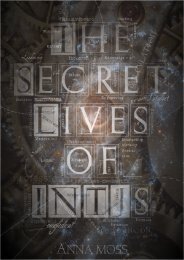You also want an ePaper? Increase the reach of your titles
YUMPU automatically turns print PDFs into web optimized ePapers that Google loves.
school she attended. Besides this, she wrote poetry—romantic poetry—about her future husband,<br />
but reportedly did not date much. (Fantasizing about one's true love in poems, but not actually<br />
pursuing numerous relationships screams INF.) She was good at English Lit, an NF favorite, but<br />
weak in Algebra, an NT favorite.<br />
Monk's incredible ability to make instant connections between widely separated details came out<br />
unexpectedly when it came to his wife. After her death, he was walking down the street when he<br />
noticed something significant—he couldn't figure out what—about a woman he had never met<br />
before. It was only later that he realized what had struck him about her. Trudy was an organ donor,<br />
and when she died, her corneas were implanted into the other woman. The stranger actually had<br />
Trudy's eyes. Monk could recognize them anywhere.<br />
Monk grieving process offers another window into the INTJ psyche. He talked to his wife as<br />
though she were still alive, and frequently imagined scenes of his old life with her. INTs have an<br />
excellent imagination, and when they are in love they can play out long, vivid scenes about dates or<br />
intimate encounters with their beloved. 283 In Monk's case, he continued to vividly remember his life<br />
with Trudy.<br />
Intuitives, with their penchant for abstract thinking, find it easier to imagine that their beloved is<br />
still around, but perhaps located on a different plane of existence. 284 Trudy, who was probably also<br />
an intuitive, understood this way of looking at death; her last words were "bread and butter," a sort<br />
of in-joke between her and her husband which indicated that though they might be apart<br />
temporarily, they were not actually gone from each other forever.<br />
Less characteristic of the intuitive preference is Monk's habit of hanging onto all kinds of large and<br />
small mementos of his wife; for instance, a key ring, a Christmas present, etc., that reminded him of<br />
her. Keeping around the possessions of the deceased is more of a sensor trait.<br />
Sharona, the ESTP Foil<br />
One of the interesting things about characters is that they tend to come equipped with an ESP<br />
sidekick who serves as a foil. All of the INTJ detectives I have profiled have had an SP partner, and<br />
ESTPs were particularly favored. (This includes two more INTJ detectives who I did not list here.<br />
If you're curious, check out A.J. Simon, an INTJ private detective from the show Simon & Simon,<br />
and Jupiter Jones, the INTJ leader of a boy's detective club from The Three Investigators series.)<br />
Naturally, we are curious why all these ESPs (and particularly ESTPs) keep popping up. It can't be<br />
a coincidence, can it? The answer to this question lies in the concept of "foils." A foil is a character<br />
who has a nature opposite that of the hero. The foil serves several purposes: to make the hero's<br />
personality stand out more; to balance the hero's strengths; and to compensate for the hero's<br />
weaknesses. In this case, the letters ESP compliment and compensate for the letters INJ. But why<br />
ESTPs, then? Shouldn't the ideal INTJ foil be an ESFP?<br />
If I had to guess, I'd say that ESFPs are considered a little too "soft" to handle a TJIN. ESTPs are<br />
the most dominant of the Artisans, and they won't be pushed around or overawed by their INTJ<br />
counterpart's abilities and thinking tough streak. Besides this, the crime genre has many uses for<br />
ESTP skills, i.e. fighting, schmoozing, acting, etc. In other genres the T/F conventions may be<br />
different. In Pride and Prejudice, for example, Mr. Darcy had an ESFP foil, his friend Mr. Bingley.<br />
(And Bingley did indeed defer to Darcy.)<br />
Monk's foil was Sharona, an ESTP and his nurse. She didn't take much from him, and was never<br />
283 Kroeger & Thuesen, 1994<br />
284 Tagliaferre & Harbaugh, 1990




